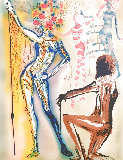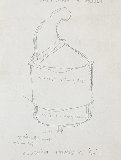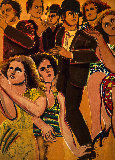



Fleur de Lumiere 1970
Man Ray
Limited Edition Print : Etching and Aquatint on Paper
Size : 26x19.5 in | 66x50 cm
Edition : From the edition of 25
Reduced
- Hand Signed Etching with Aquatint $2,975
Year1970
Hand SignedLower Right in Pencil
Condition Excellent
Not Framed
Purchased fromPrivate Collector 2017
Certificate of AuthenticityArt Brokerage
LID106371
Man Ray - United States
Art Brokerage; Man Ray American Artist: b. 1890-1976. Man Ray was born Emmanuel Radnitsky in Philadelphia on August 27, 1890. With bitter memories of teasing at school because of his foreign sounding name, he became Man Ray in his early twenties. At an early age he became adept at building, repairing, inventing and sketching. Refusing a scholarship to study architecture, Man Ray supported himself as a commercial artist and draftsman, while studying art in night classes at various schools in New York. Exposed to Cubism at the 1913 Armory Show, the artist soon incorporated those stylistic elements in his work, met Marcel Duchamp, and bought his first camera. His close friendship with Duchamp, spanning fifty-five years, influenced their respective work and resulted in collaborative creative endeavors. Encouraged by Duchamp, May Ray moved to Paris in 1921, and with the exception of ten years in Hollywood during World War II, he spent the rest of his life there. He joined the Parisian Dada group and then the Surrealists. Possessing an endlessly fertile imagination, Man Ray continued to create new and startling artworks throughout his long career. Always at the forefront of the avant garde, he experimented with every conceivable medium, invented a number of his own and influenced several generations of artists. His major contributions fall into the categories of painting, sculpture and photography, including film. His work included readymades, assisted readymades, and assorted assemblages--often more complex than they seemed--involving complicated puns and hidden implications. His objects, he said, were always "designed to amuse, annoy, bewilder, mystify, inspire reflection, but not to arouse admiration for any technical excellence usually sought or valued in objects classified as works of art." Much of his work was developed for its shock value. Some of his objects, destroyed by visitors to their exhibitions, or lost (like Cadeau ), were re-created later. During the six decades of his career, Man Ray had innumerable one-man shows. Listings wanted. Check out our new sister site Bluechipartbrokerage.com
































































